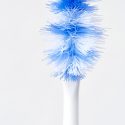
|

|

|

|
Toothbrush Abrasion

Everyone knows that brushing your teeth is one of the most fundamental steps in maintaining good oral health. Aside from preventing decay and gum disease, this keeps your mouth feeling clean, your breath smelling fresh, and helps prevent staining. What many people are less aware of is that too much brushing can actually harm your teeth. In the same way repetitive waves can erode away at a rocky coastline, incorrect brushing can cause the gums to wear away, and the exposed tooth root can develop deep notches. We call this condition “abrasion”. It is usually caused by brushing too long, pressing too firmly or using a hard- or medium-bristled brush (soft only!).
Abrasion can cause many problems. Apart from the visual aesthetic, it can cause sensitivity and/or pain, and leave areas more susceptible to food packing, decay and gum disease. Longer term, severe notches in the teeth can get deep enough to expose the nerve of the tooth. Here are some simple things we can do to help prevent toothbrush abrasion:
The two-minute rule.
Two minutes is the base rule for the length of time required to brush your teeth. This is the minimum time it should take you to move over the teeth to have properly cleaned them. As most adults have 28-32 teeth, spending 120 seconds brushing only leaves about 4 seconds for each tooth, so it really isn’t that long!
Time is not a common factor in abrasion on the teeth, but if you are in the habit of brushing your teeth more than 2-3 times per day you run the risk of causing damage to your teeth. It is always best to consult with your dentist if you are unsure.
So what toothbrush should you use?
Whether to use an electric or manual is a question we get asked pretty regularly. Really, neither is ‘better’ so long as you are using it properly.
- For manual brushes, using gentle circular motions angled towards the gumline is ideal to target areas of food accumulation. If you work around the mouth in a regular order you will be less likely to forget about any teeth. It is also recommended to only use a soft or extra-soft strength bristle as anything harder can have too much abrasive power even with gentle pressure. It is important to remember the movement (not the pressure) of your brush is what will clean effectively.
- One obvious way you can tell if you’re pressing too hard is if your toothbrush is becoming frayed and the bristles are sticking out after only a few weeks of use.
- Electric brushes do the circular motions for you, so you only need to angle the brush and hold it over each tooth rather than doing any motion yourself, meaning they can be better for those with decreased dexterity of the hands (arthritis, motor disorders). However, many people find them overall easier to use, and they are also fantastic for people who have a tendency to scrub in a back and forth motion over their teeth as the lack of motion breaks this habit.
Treatment of Abrasion.
Treating (or not treating) teeth that have had abrasive damage is dependent on the depth of the lesions and whether the areas are a source of pain/sensitivity. The most important step once toothbrush abrasion is identified is stopping progression of the lesions any further – by eliminating the cause.
Other treatment can range from sensitive toothpastes, in-office application of desensitising agents, or to filling deep lesions. However, none of these treatments will be longstanding or effective if the abrasive cause is continued so please book in to see us if you are at all concerned!






